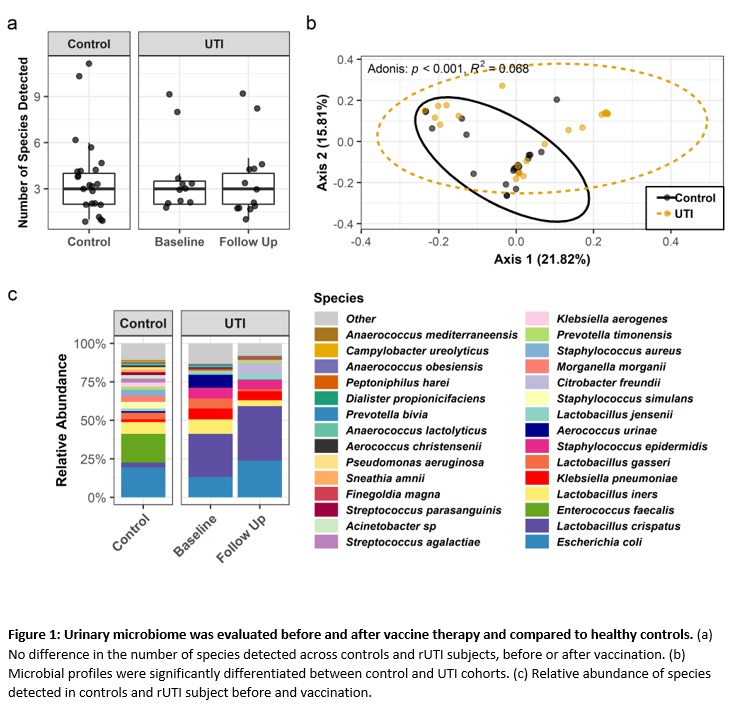Back
Poster, Podium & Video Sessions
MP02: Infections/Inflammation/Cystic Disease of the Genitourinary Tract: Kidney & Bladder I
MP02-14: Re-imagining urinary tract infection in women: Clues from the urobiome of asymptomatic healthy controls vs vaccinated women with recurrent urinary tract infection
Friday, May 13, 2022
7:00 AM – 8:15 AM
Location: Room 225
J. Curtis Nickel*, R. Christopher Doiron, Kerri-Lynn Kelly, Kingston, Canada, Nicolle Diaz, Caleb D. Phillips, Craig D. Tipton, Lubbock, TX

Curtis J. Nickel, MD, FRCSC (he/him/his)
Professor of Urology
Queen's University at Kingston Canada
Poster Presenter(s)
Introduction: A comparison of the urobiome of healthy controls with no UTI to women with recurrent UTI (rUTI) before and after MV140 vaccination would suggest that our traditional concept of rUTI in women may be more complicated than envisioned.
Methods: Female subjects with rUTI (=3 UTIs/year) enrolled in the MV140 North American early clinical experience study and age–matched asymptomatic females (about 1:2 ratio) with no UTI or antibiotics in the previous 12 and 3 months respectively provided midstream urine specimens for culture, NGS and quantitative PCR testing (MicroGenDx) at baseline and for the rUTI group, following the 3-month vaccination period.
.
Results: The urobiome of 13 rUTI patients with sterile urine did not differ significantly in number of species (Anova; p = 0.96, Fig 1a) although species composition differed significantly (nested ADONIS; p<0.001, R2=0.068, Figs 1b,c) from 23 age-matched healthy controls. This composition difference was driven by some species more abundant in the rUTI patients (e.g., Finegoldia magna), though other potentially pathogenic species were similarly abundant or more abundant in controls (eg. E. coli and Enterococcus faecalis, respectively). There was no significant change in NGS detected number of species (Anova; p = 0.91, R2 = 0.001, Fig 1a) or species detected (Fig 1c) 3 months after vaccination in the rUTI group. Similarly, there was no difference in qPCR estimated bacterial load following 3-month vaccination period in the rUTI group (Anova; p = 0.83, R2 = 0.001).
Conclusions: The urobiome comparison between healthy and rUTI subjects and lack of impact of a successful vaccine on the urobiome of rUTi patients would suggest that we need to re-look at interaction of bacterial virulence and the local bladder immune mechanisms and even origin of the organisms that cause UTI. This small study suggests that UTI may arise from the patients’ own native urinary microbiome that in healthy individuals may be modulated by local bladder innate immunological mechanisms. In patients with rUTI those deficient mucosal–based mechanisms may be enhanced by an effective vaccine. This possible concept–shift regarding the cause of rUTI in women would have profound management implications.
Source of Funding: Inmunotek, MicroGenDx

Methods: Female subjects with rUTI (=3 UTIs/year) enrolled in the MV140 North American early clinical experience study and age–matched asymptomatic females (about 1:2 ratio) with no UTI or antibiotics in the previous 12 and 3 months respectively provided midstream urine specimens for culture, NGS and quantitative PCR testing (MicroGenDx) at baseline and for the rUTI group, following the 3-month vaccination period.
.
Results: The urobiome of 13 rUTI patients with sterile urine did not differ significantly in number of species (Anova; p = 0.96, Fig 1a) although species composition differed significantly (nested ADONIS; p<0.001, R2=0.068, Figs 1b,c) from 23 age-matched healthy controls. This composition difference was driven by some species more abundant in the rUTI patients (e.g., Finegoldia magna), though other potentially pathogenic species were similarly abundant or more abundant in controls (eg. E. coli and Enterococcus faecalis, respectively). There was no significant change in NGS detected number of species (Anova; p = 0.91, R2 = 0.001, Fig 1a) or species detected (Fig 1c) 3 months after vaccination in the rUTI group. Similarly, there was no difference in qPCR estimated bacterial load following 3-month vaccination period in the rUTI group (Anova; p = 0.83, R2 = 0.001).
Conclusions: The urobiome comparison between healthy and rUTI subjects and lack of impact of a successful vaccine on the urobiome of rUTi patients would suggest that we need to re-look at interaction of bacterial virulence and the local bladder immune mechanisms and even origin of the organisms that cause UTI. This small study suggests that UTI may arise from the patients’ own native urinary microbiome that in healthy individuals may be modulated by local bladder innate immunological mechanisms. In patients with rUTI those deficient mucosal–based mechanisms may be enhanced by an effective vaccine. This possible concept–shift regarding the cause of rUTI in women would have profound management implications.
Source of Funding: Inmunotek, MicroGenDx


.jpg)
.jpg)